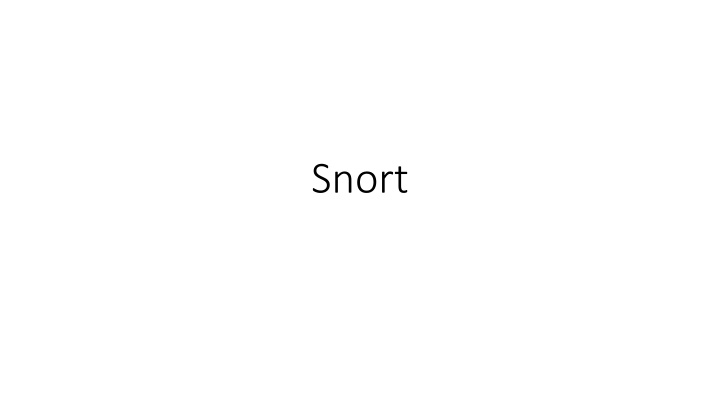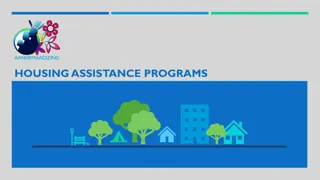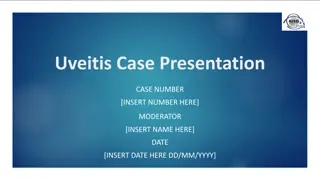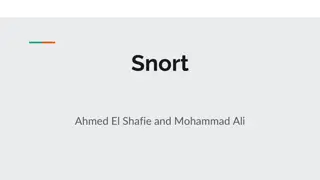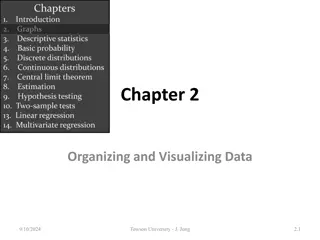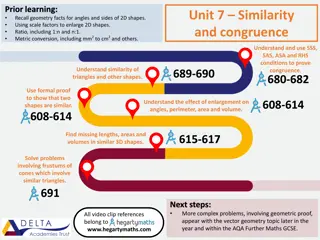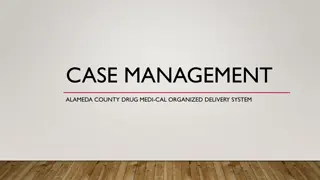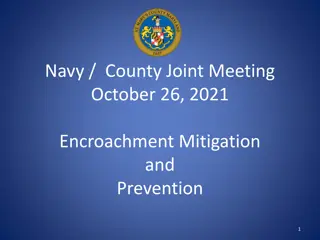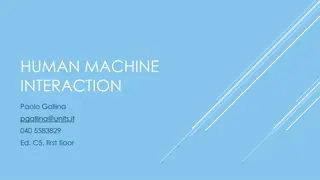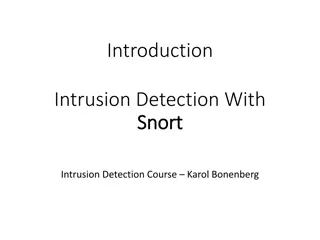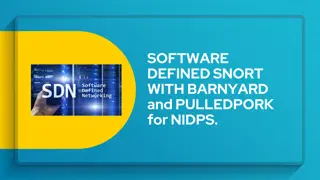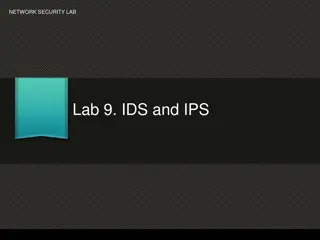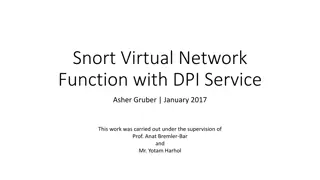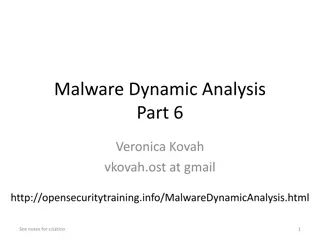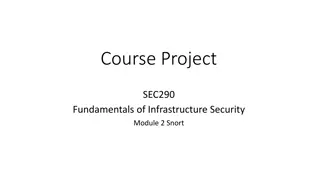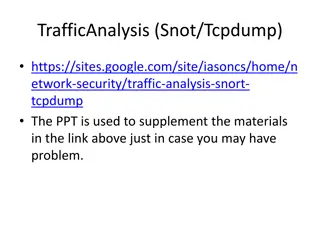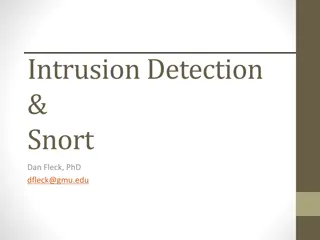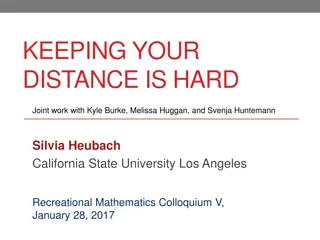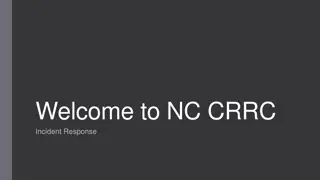Snort: A Comprehensive Overview
Snort is an open-source network intrusion detection system (NIDS) widely utilized in the industry. It employs a rule-based language combining various inspection methods to detect malicious activities like denial of service attacks and port scans. The components, architecture, and detection engine of Snort are explored here, shedding light on its packet sniffing capabilities, logging system, and more. With a detailed look at its logical components and rules, this article aims to provide a thorough understanding of Snort's functionality and importance in network security.
Download Presentation

Please find below an Image/Link to download the presentation.
The content on the website is provided AS IS for your information and personal use only. It may not be sold, licensed, or shared on other websites without obtaining consent from the author.If you encounter any issues during the download, it is possible that the publisher has removed the file from their server.
You are allowed to download the files provided on this website for personal or commercial use, subject to the condition that they are used lawfully. All files are the property of their respective owners.
The content on the website is provided AS IS for your information and personal use only. It may not be sold, licensed, or shared on other websites without obtaining consent from the author.
E N D
Presentation Transcript
Overview What s snort? Snort architecture Snort components Detection engine and rules in snort Possible research works in snort.
Whats snort? NIDS: A network intrusion detection system (NIDS) is an intrusion detection system that tries to detect malicious activity such as denial of service attacks, port scans or even attempts to crack into computers by monitoring network traffic. Snort: an open source network intrusion prevention and detection system. It uses a rule-based language combining signature, protocol and anomaly inspection methods Snort: the most widely deployed intrusion detection and prevention technology and it has become the de facto standard technology worldwide in the industry.
Snort 1. 2. 3. 4. A packet sniffer: capture and display packets from the network with different levels of detail on the console Packet logger: log data in text file Honeypot monitor: deceiving hostile parties NIDS: network intrusion detection system
Snort architecture From: Nalneesh Gaur, Snort: Planning IDS for your enterprise, http://www.linuxjournal.com/article/4668, 2001.
Snort components From: Rafeeq Ur Rehman, Intrusion Detection Systems with Snort: Advanced IDS Techniques with Snort, Apache, MySQL, PHP, and ACID.
Logical components of snort Packet Decoder: takes packets from different types of network interfaces (Ethernet, SLIP,PPP ), prepare packets for processing Preprocessor: (1) prepare data for detection engine; (2) detect anomalies in packet headers; (3) packet defragmentation;(4) decode HTTP URI; (5) reassemble TCP streams. Detection Engine: the most important part, applies rules to packets Logging and Alerting System Output Modules: process alerts and logs and generate final output.
Detection engine Number of rules Traffic load on the network Speed of network and machine Efficiency of detection algorithm
Rules In a single line Rules are created by known intrusion signatures. rule header rule options
Snort Rule destination ip address Apply to all ip packets Destination port Source ip address Source port # Rule options Alert will be generated if criteria met Rule header
Snort Rules Snort rules are extremely flexible and are easy to modify, unlike many commercial NIDS Sample rule to detect SubSeven trojan: alert tcp $EXTERNAL_NET 27374 -> $HOME_NET any (msg:"BACKDOOR subseven 22"; flags: A+; content: "|0d0a5b52504c5d3030320d0a|"; reference:arachnids,485; reference:url,www.hackfix.org/subseven/; sid:103; classtype:misc-activity; rev:4;) Elements before parentheses comprise rule header Elements in parentheses are rule options
Snort Rules alert tcp $EXTERNAL_NET 27374 -> $HOME_NET any (msg:"BACKDOOR subseven 22"; flags: A+; content: "|0d0a5b52504c5d3030320d0a|"; reference:arachnids,485; reference:url,www.hackfix.org/subseven/; sid:103; classtype:misc-activity; rev:4;) alert action to take; also log, pass, activate, dynamic tcp protocol; also udp, icmp, ip $EXTERNAL_NET source address; this is a variable specific IP is ok 27374 source port; also any, negation (!21), range (1:1024) -> direction; best not to change this, although<>is allowed $HOME_NET destination address; this is also a variable here any destination port
Snort Rules alert tcp $EXTERNAL_NET 27374 -> $HOME_NET any (msg:"BACKDOOR subseven 22"; flags: A+; content: "|0d0a5b52504c5d3030320d0a|"; reference:arachnids,485; reference:url,www.hackfix.org/subseven/; sid:103; classtype:misc-activity; rev:4;) msg: BACKDOOR subseven 22 ; message to appear in logs flags: A+; tcp flags; many options, like SA, SA+, !R, SF* content: |0d0 0a| ;binary data to check in packet; content without | (pipe) characters do simple content matches reference ;where to go to look for background on this rule sid:103; rule identifier classtype: misc-activity; rule type; many others rev:4;rule revision number other rule options possible, like offset, depth, nocase
Snort Rules bad-traffic.rules finger.rules smtp.rules dos.rules tftp.rules web-frontpage.rules web-iis.rules web-attacks.rules icmp.rules backdoor.rules porn.rules virus.rules exploit.rules ftp.rules rpc.rules ddos.rules web-cgi.rules scan.rules telnet.rules rservices.rules dns.rules web-coldfusion.rules web-misc.rules x11.rules misc.rules sql.rules netbios.rules shellcode.rules policy.rules info.rules local.rules icmp-info.rules attack-responses.rules
Snort Rules Rules which actually caught intrusions alert tcp $EXTERNAL_NET any -> $SQL_SERVERS 1433 (msg:"MS-SQL xp_cmdshell - program execution"; content: "x|00|p|00|_|00|c|00|m|00|d|00|s|00|h|00|e|00|l|00|l|00|" ; nocase; flags:A+; classtype:attempted-user; sid:687; rev:3;) caught compromise of Microsoft SQL Server alert tcp $EXTERNAL_NET any -> $HTTP_SERVERS 80 (msg:"WEB-IIS cmd.exe access"; flags: A+; content:"cmd.exe"; nocase; classtype:web-application- attack; sid:1002; rev:2;) caught Code Red infection alert tcp $EXTERNAL_NET any -> $HOME_NET 21 (msg:"INFO FTP \"MKD / \" possible warez site"; flags: A+; content:"MKD / "; nocase; depth: 6; classtype:misc- activity; sid:554; rev:3;) caught anonymous ftp server
Detection engine order to scan the rules Snort does not evaluate the rules in the order that they appear in the Snort rules file. In default, the order is: Alert rules Pass rules Log rules 1. 2. 3.
Challenges with snort Misuse detection avoid known intrusions Rules database is larger and larger It continues to grow snort version 2.3.2, there are 2,600 rules 80% of them are signatures Snort spends 80% work time to do string match Anomaly detection identify new attacks Probability of detection is low
Snort 1. Download Snort from the Snort.org website. (http://www.snort.org/snort-downloads) 2. Download Rules from here. 3. Double click on the .exe to install snort. This will install snort in the C:\Snort folder. It is important to have WinPcap installed
Snort 4. Extract the Rules file. You will need WinRAR for the .gz file. 5. Copy all files from the rules folder of the extracted folder. Now paste the rules into C:\Snort\rules folder. 6. Copy snort.conf file from the etc folder of the extracted folder. You must paste it into C:\Snort\etc folder. Overwrite any existing file. Remember if you modify your snort.conf file and download a new file, you must modify it for Snort to work.
Snort 7. Open a command prompt (cmd.exe) and navigate to folder C:\Snort\bin folder. ( at the Prompt, type cd\snort\bin) 8. To start (execute) snort in sniffer mode use following command: snort -dev -i 3 -i indicates the interface number. You must pick the correct interface number. In my case, it is 3. -dev is used to run snort to capture packets on your network.
Snort 9. To run snort in IDS mode, you will need to configure the file snort.conf according to your network environment. 10. To specify the network address that you want to protect in snort.conf file, look for the following line. var HOME_NET 192.168.1.0/24 (You will normally see any here) 11. You may also want to set the addresses of DNS_SERVERS, if you have some on your network.
Snort 12. Change the RULE_PATH variable to the path of rules folder. var RULE_PATH c:\snort\rules 13. Change the path of all library files with the name and path on your system. and you must change the path of snort_dynamicpreprocessorvariable. C:\Snort\lib\snort_dynamiccpreprocessor You need to do this to all library files in the C:\Snort\lib folder. The old path might be: /usr/local/lib/ . you will need to replace that path with your system path. Using C:\Snort\lib 14. Change the path of the dynamicengine variable value in the snort.conf file.. Example: dynamicengine C:\Snort\lib\snort_dynamicengine\sf_engine.dll
Snort 15 Add the paths for include classification.config and include reference.config files. include c:\snort\etc\classification.config include c:\snort\etc\reference.config 16. Remove the comment (#) on the line to allow ICMP rules, if it is commented with a #. include $RULE_PATH/icmp.rules 17. You can also remove the comment of ICMP-info rules comment, if it is commented. include $RULE_PATH/icmp-info.rules
Snort 18. To add log files to store alerts generated by snort, search for the output log test in snort.conf and add the following line: output alert_fast: snort-alerts.ids 19. Comment (add a #) the whitelist $WHITE_LIST_PATH/white_list.rules and the blacklist Change the nested_ip inner , \ to nested_ip inner #, \ 20. Comment out (#) following lines: #preprocessor normalize_ip4 #preprocessor normalize_tcp: ips ecn stream #preprocessor normalize_icmp4 #preprocessor normalize_ip6 #preprocessor normalize_icmp6 21. Save the snort.conf file.
Snort 22. To start snort in IDS mode, run the following command: snort -c c:\snort\etc\snort.conf -l c:\snort\log -i 3 (Note: 3 is used for my interface card) If a log is created, select the appropriate program to open it. You can use WordPard or NotePad++ to read the file. To generate Log files in ASCII mode, you can use following command while running snort in IDS mode: snort -A console -i3 -c c:\Snort\etc\snort.conf -l c:\Snort\log -K ascii 23. Scan the computer that is running snort from another computer by using PING or NMap (ZenMap). After scanning or during the scan you can check the snort-alerts.ids file in the log folder to insure it is logging properly. You will see IP address folders appear.
